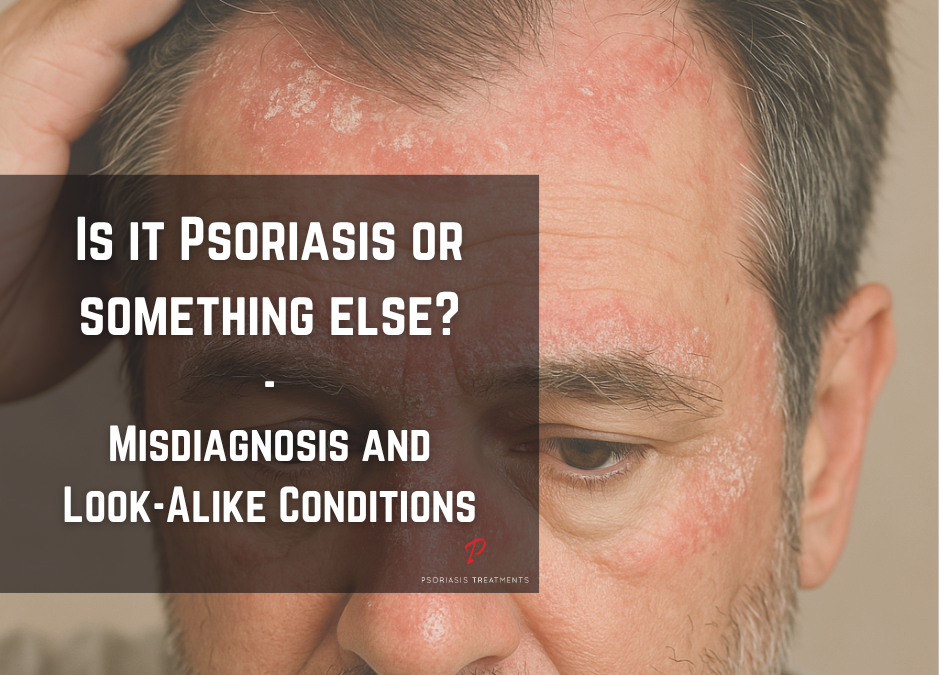Psoriasis is a chronic, immune-related skin disease that can present in various ways—from red scaly patches and plaques to joint pain and nail changes. Because of this variability, it’s not uncommon for even experienced clinicians to misidentify it. Many people initially diagnosed with something else later discover they’ve been dealing with psoriasis all along.
In this article, we’ll explore why misdiagnosis is so frequent, highlight conditions that resemble psoriasis, and help you understand when to question a diagnosis that doesn’t feel quite right.
Why Psoriasis Is Easy to Confuse with Other Conditions
Psoriasis has many faces. Some people experience thick plaques with silvery scales, while others only have joint inflammation or small scattered red patches. Depending on how and where symptoms appear, psoriasis can resemble eczema, fungal infections, lupus, or even skin cancer.
The immune system plays a central role in psoriasis. However, other autoimmune or inflammatory diseases trigger similar symptoms such as redness, itchiness, scaling, pain, and swelling, which complicates the diagnostic process. In many cases, the diagnosis only becomes clear after months or even years of trial and error with treatments that don’t work.
Complicating matters further, psoriasis often overlaps with other health issues. About 30% of patients with skin psoriasis will eventually develop psoriatic arthritis, sometimes years later. A large number of people who are ultimately diagnosed with psoriatic arthritis report receiving one or more incorrect diagnoses first. This is especially common when joint pain is the dominant symptom and skin signs are subtle or absent.
How Psoriasis Compares to Similar Conditions
One of the most common psoriasis mimics is eczema (atopic dermatitis). While both conditions cause red, itchy skin, eczema usually starts earlier in life and tends to appear in the bends of the elbows or behind the knees. Psoriasis often affects the outer sides of those joints and features thicker, well-defined plaques with dry, silver scaling. Eczema, by contrast, may ooze or crust, especially after scratching. Want to read more? Follow guide to understand the key differences between psoriasis and eczema conditions and provide tips on identifying them.
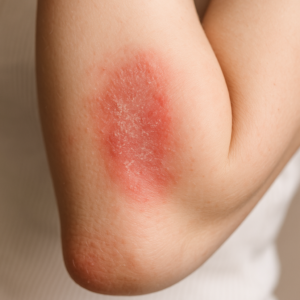
Eczema often appears as red, itchy patches in body creases such as elbows, knees, and neck folds.
Seborrheic dermatitis, which causes flaking and irritation on the scalp, face, or upper chest, can resemble scalp psoriasis. But psoriasis usually causes thicker, more defined plaques with dry scaling. Seborrheic dermatitis tends to produce yellowish flakes and greasy redness.

Seborrheic dermatitis is a chronic scalp condition that may mimic scalp psoriasis.
Fungal infections such as ringworm or jock itch also confuse the picture. These typically appear as ring-shaped lesions with clearer skin in the center, while psoriasis tends to cover the area more uniformly. In warm, moist body folds, fungal infections and inverse psoriasis can be especially difficult to distinguish without testing.
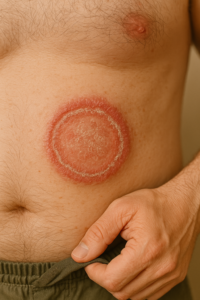
Ringworm presents as an itchy, ring-like rash and can be mistaken for psoriasis or eczema.
A temporary skin condition called pityriasis rosea can also mimic psoriasis, especially guttate psoriasis. It often starts with a single large “herald patch” on the trunk, followed by smaller scaly spots that follow skin tension lines. Unlike psoriasis, pityriasis rosea generally resolves on its own within a couple of months.
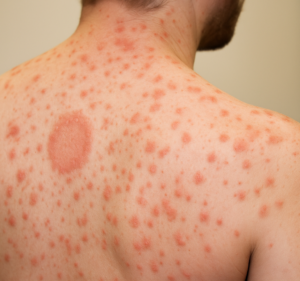
Pityriasis rosea starts with a herald patch and spreads in a “Christmas tree” pattern across the trunk.
In some cases, lupus-related skin conditions (such as discoid lupus) can produce red, scaly plaques that look like psoriasis. However, lupus rashes may scar or leave pigment changes, and they often worsen with sun exposure. Systemic lupus also brings symptoms like fatigue or fever, which aren’t typical for psoriasis.
Psoriatic arthritis can also be confused with other types of arthritis, especially rheumatoid arthritis. The two conditions can look similar, but psoriatic arthritis often causes swelling in the fingers or toes, sometimes affecting the entire digit. It tends to affect joints asymmetrically and can also cause pain at tendon attachment points. Rheumatoid arthritis usually affects the same joints on both sides of the body.
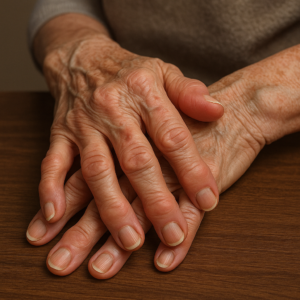
Rheumatoid arthritis causes symmetrical joint swelling and stiffness, often confused with psoriatic arthritis.
When to Reevaluate a Diagnosis
If your treatment isn’t helping or if your symptoms don’t fully align with your diagnosis, it’s reasonable to ask questions and seek further evaluation. A misdiagnosis doesn’t necessarily mean an error occurred; it may just reflect the complexity of inflammatory conditions.

Nail fungus causes thick, discolored nails and may resemble psoriatic nail changes.
Specialists like dermatologists and rheumatologists are best equipped to navigate these cases. A skin biopsy, blood tests, or even a symptom diary can offer valuable clues. Photos of previous flare-ups can help illustrate how your condition has changed over time.
Even if you’ve been treated for a specific diagnosis for years, it may be worth reassessing if your symptoms shift or stop responding to treatment. Psoriasis and its mimics are well-studied, and there are reliable ways to distinguish between them. Sometimes, a second opinion can make all the difference.
Staying Proactive in Complex Diagnoses
It’s frustrating to feel stuck in limbo with a skin or joint condition. If something about your diagnosis doesn’t sit right, or your symptoms evolve, don’t hesitate to revisit the discussion with your care provider. While psoriasis shares features with many other conditions, trained specialists can often recognize its telltale signs.
Accurate diagnosis is the first step toward effective treatment. Whether you’re dealing with psoriasis or another condition entirely, staying informed and involved in your care gives you the best chance at long-term relief and clarity.
| Condition | Why It’s Similar | Key Differences |
|---|---|---|
| Eczema (Atopic Dermatitis) | Red, itchy patches; can scale | Eczema is itchier, usually starts in childhood, favors creases (e.g. inside elbows), and may ooze. Psoriasis tends to be thicker, with silvery scale and on outer elbows/knees. |
| Seborrheic Dermatitis (Dandruff) | Flaky scalp, redness | Dandruff is greasy/yellowish with oily scalp; psoriasis is dry, thick, and silvery. Psoriasis often extends beyond the hairline. |
| Fungal Infections (e.g. Ringworm, Jock Itch) | Red, scaly patches | Fungal rashes are ring-shaped with clear centers. Psoriasis plaques are more uniform and not circular. Fungal infections often itch more intensely. |
| Pityriasis Rosea | Red, scaly rash | Starts with a single “herald patch” and resolves on its own in 6–8 weeks. Psoriasis is chronic and lacks this pattern. Often affects teens/young adults. |
| Lupus (Cutaneous or Systemic) | Red scaly plaques, joint pain | Lupus often leaves scars, is sun-sensitive, and may cause systemic symptoms (fever, fatigue). Psoriasis is more localized to skin/joints and rarely causes systemic illness. |
| Rheumatoid Arthritis (RA) | Joint pain and swelling | RA is symmetric and hits different joints than psoriatic arthritis. PsA may also cause skin plaques and “sausage” digits (dactylitis). |
| Osteoarthritis (OA) | Joint pain and stiffness | OA is degenerative (wear-and-tear), not autoimmune. PsA affects younger people, often with morning stiffness and nail changes. |
| Gout | Sudden joint swelling and pain | Gout comes in acute attacks, often in the big toe. PsA is more chronic and widespread. |
| Nail Fungus | Thick, discolored nails | Fungal nails can mimic nail psoriasis. A lab test can distinguish them. |
| Lichen Planus | Scaly, itchy patches | Typically purple-toned and flat-topped; often in wrists, ankles, and mouth. Psoriasis is usually red with silver scale. |
| Secondary Syphilis | Widespread scaly rash | May affect palms/soles; rare but can look like guttate psoriasis. Confirmed via blood tests. |
| Skin Cancer | Scaly or bleeding lesions | Unusual or changing patches could be cancer (e.g. squamous cell carcinoma). Biopsy is needed if a plaque doesn’t behave like usual psoriasis. |

